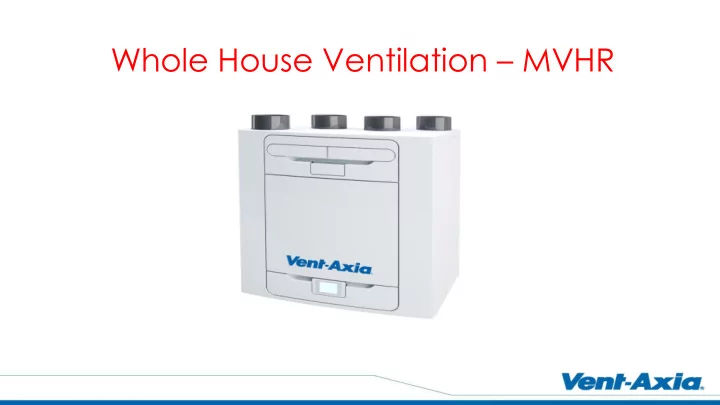

Whole House Ventilation – MVHR
Agenda • Introduction • MVHR Market • Building Regulations – Where are we going? • What is MVHR? • What does it mean for you? - Why get behind the range • How can we help • Questions
MVHR Market Data
Introduction • New buildings are becoming increasingly airtight • Demand for continuous mechanical ventilation is increasing • Building Regulations are favouring MVHR in new homes • 95% of Vent-Axia MVHR business specification driven • More enquiries through electrical distribution • Massive opportunities as housing market improves
Building Regulations • 1992 – Ventilation was first introduced into Building Regs. • 2006 – Ventilation systems were being installed by skilled persons but the performance data was never recorded. • 2010 – Ventilation systems had to be installed correctly and airflow rates measured. More demand for mechanical ventilation with heat recovery. • 2016 – Mechanical ventilation with heat recovery the most likely choice. Buildings require a significant reduction in carbon emissions.
Building Regulations Four key areas the Building Regulations are seeking to improve: 1) Installed airflow performance 2) Energy efficiency 3) Good quality installation 4) Ease of use by home occupier
Types of ventilation • System 1 – Background ventilation and intermittent extract systems (including cooker hoods) • System 2 – Passive stack ventilation • System 3 – Continuous mechanical extract (MEV/dMEV) • System 4 – Continuous mechanical supply and extract with heat recovery (MVHR)
What is MEV/dMEV? • Extract stale air from wet rooms • Fresh air supplied in through background (trickle) vents
Issues with MEV/dMEV? • Loss of heat from the dwelling • No filtration of air into the property • Noise control
What is MVHR? • Unit is centrally located – normally in a loft or cupboard • Extract and input vents are connected to the central unit using rigid ducting • Air is extracted from wet rooms – bathrooms, kitchens etc
System 3 – MEV
What is MVHR? • Fresh filtered air is supplied into other habitable rooms – living rooms, bedrooms, dining rooms • The extracted air is passed over a heat exchanger in the MVHR unit. The heat in the extracted air is removed and used to heat incoming air
System 4 – MVHR
How does MVHR work? • The unit incorporates a heat exchanger that tempers the incoming air before it is delivered to the habitable rooms.
How does MVHR work?
Energy Saving – why heat twice?
What does this mean for you • With demand increasing for MHVR more contractors are getting involved with the installation. • However the supply chain has widened and it is essential to make sure you achieve your fair share. • There are many advantages of increasing your turnover in this sector.
What does this mean for you • With the units making up part of a whole house system the transactional value is much higher. • Giving you a larger cash margin per job and subsequently helping you achieve your targets much quicker. • This in turn helps you achieve your rebate bands sooner and further increasing your overall profits.
How can we help? • Free design service • Joint site visits to utilise our expert sales force to ensure better conversion rate • In branch training given to staff and aim to allocate a ventilation champion with CDP certificates added and on line material, • Installer BPEC training programme done in conjunction with your branches • On Line Fan selector
CPD Training • How do you access Vent- Axia CPD’s? We come to you: Simply choose the subject you require and a Vent- Axia specialist will arrange a seminar to be delivered at your premises. This normally takes place during a lunch hour or after working hours thus not taking up too much of the working day. • Following the seminar each delegate will receive a certificate for 1 hour CPD for their records
BPEC Training & Leading SAP Appendix Q Products (PPL)
Thank you Questions?
Recommend
More recommend